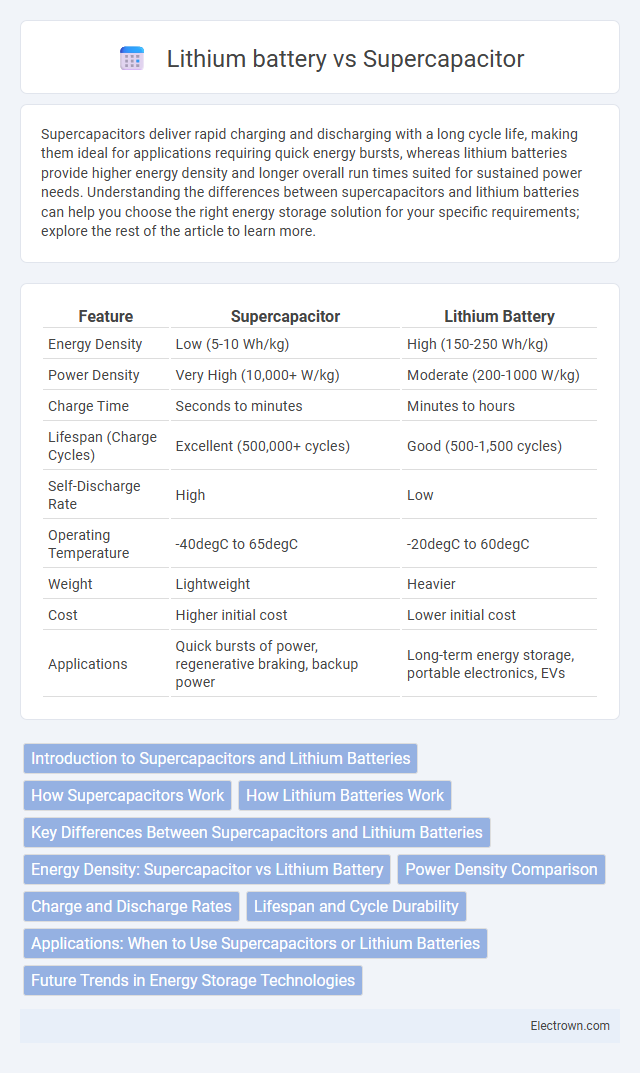Supercapacitors deliver rapid charging and discharging with a long cycle life, making them ideal for applications requiring quick energy bursts, whereas lithium batteries provide higher energy density and longer overall run times suited for sustained power needs. Understanding the differences between supercapacitors and lithium batteries can help you choose the right energy storage solution for your specific requirements; explore the rest of the article to learn more.
Table of Comparison
| Feature | Supercapacitor | Lithium Battery |
|---|---|---|
| Energy Density | Low (5-10 Wh/kg) | High (150-250 Wh/kg) |
| Power Density | Very High (10,000+ W/kg) | Moderate (200-1000 W/kg) |
| Charge Time | Seconds to minutes | Minutes to hours |
| Lifespan (Charge Cycles) | Excellent (500,000+ cycles) | Good (500-1,500 cycles) |
| Self-Discharge Rate | High | Low |
| Operating Temperature | -40degC to 65degC | -20degC to 60degC |
| Weight | Lightweight | Heavier |
| Cost | Higher initial cost | Lower initial cost |
| Applications | Quick bursts of power, regenerative braking, backup power | Long-term energy storage, portable electronics, EVs |
Introduction to Supercapacitors and Lithium Batteries
Supercapacitors store energy through electrostatic charge separation, offering rapid charge and discharge cycles with high power density and long cycle life. Lithium batteries rely on chemical reactions to store energy, providing higher energy density suitable for long-term energy storage but with slower charge rates and limited cycle life. Both technologies serve distinct roles in energy storage, with supercapacitors excelling in short bursts of power and lithium batteries supporting sustained energy demands.
How Supercapacitors Work
Supercapacitors store energy through the physical separation of electrical charges, utilizing an electric double-layer capacitance and pseudocapacitance without chemical reactions, enabling rapid charge and discharge cycles. Their design includes porous carbon electrodes and an electrolyte that facilitates ion movement, resulting in high power density and exceptional cycle life compared to lithium batteries. When choosing energy storage, understanding that supercapacitors excel in quick energy delivery and long-term durability can help optimize your application's performance.
How Lithium Batteries Work
Lithium batteries store energy through electrochemical reactions involving lithium ions moving between the anode and cathode during charging and discharging cycles, enabling high energy density and longer-lasting power for your devices. Unlike supercapacitors that store energy electrostatically, lithium batteries rely on lithium-ion diffusion, which allows for sustained energy delivery over extended periods. Their design supports applications requiring steady, long-term energy output, such as smartphones, electric vehicles, and portable electronics.
Key Differences Between Supercapacitors and Lithium Batteries
Supercapacitors offer rapid charge and discharge cycles with high power density, whereas lithium batteries provide higher energy density for longer-lasting energy storage. Supercapacitors excel in applications requiring quick bursts of energy and extensive cycle life, while lithium batteries are better suited for sustained energy delivery over extended periods. The difference in electrochemical processes results in supercapacitors having greater durability and lower energy capacity compared to the energy-rich but slower-charging lithium batteries.
Energy Density: Supercapacitor vs Lithium Battery
Lithium batteries typically offer higher energy density, ranging from 150 to 250 Wh/kg, enabling longer-lasting power storage compared to supercapacitors which usually provide energy densities around 5 to 10 Wh/kg. Supercapacitors excel in power density and rapid charge-discharge cycles but lag behind lithium batteries in storing large amounts of energy. This makes lithium batteries more suitable for applications requiring extended energy supply, while supercapacitors are ideal for short bursts of high power.
Power Density Comparison
Supercapacitors exhibit significantly higher power density compared to lithium batteries, delivering rapid bursts of energy essential for applications requiring quick charge and discharge cycles. Lithium batteries have lower power density but provide higher energy density, making them suitable for long-term energy storage. Your choice depends on whether your priority is high power output or prolonged energy supply.
Charge and Discharge Rates
Supercapacitors exhibit significantly faster charge and discharge rates compared to lithium batteries, capable of delivering high power bursts within seconds. Lithium batteries, while offering higher energy density, typically have slower charge rates ranging from 0.5C to 3C and longer discharge times suitable for sustained energy delivery. The rapid charge-discharge capability of supercapacitors makes them ideal for applications requiring quick energy storage and release, whereas lithium batteries excel in long-duration energy supply.
Lifespan and Cycle Durability
Supercapacitors offer significantly longer lifespan and cycle durability compared to lithium batteries, with the ability to endure up to 1 million charge-discharge cycles without substantial capacity loss. In contrast, lithium batteries typically last between 500 to 1,500 cycles before noticeable degradation occurs. Your choice between these two energy storage options should consider the demanding application cycles where supercapacitors excel in longevity and rapid charge retention.
Applications: When to Use Supercapacitors or Lithium Batteries
Supercapacitors excel in applications requiring rapid charge and discharge cycles, such as regenerative braking systems, power backup for electronic devices, and energy harvesting in IoT sensors, where longevity and high power density are critical. Lithium batteries are more suited for long-duration energy storage needs, including electric vehicles, portable electronics, and renewable energy systems, where high energy density and stable output over extended periods are essential. Understanding your specific use case, such as the need for quick bursts of power versus sustained energy delivery, will help determine whether supercapacitors or lithium batteries provide the optimal solution.
Future Trends in Energy Storage Technologies
Supercapacitors exhibit rapid charge-discharge cycles and long lifespan, making them ideal for applications requiring high power density and frequent energy cycling. Lithium batteries offer higher energy density, enabling longer duration energy storage, crucial for electric vehicles and grid-level applications. Emerging hybrid systems combining supercapacitors and lithium batteries aim to optimize both power delivery and energy capacity, driving future innovations in energy storage technologies.
Supercapacitor vs Lithium battery Infographic

 electrown.com
electrown.com